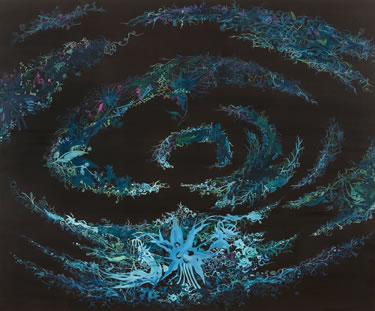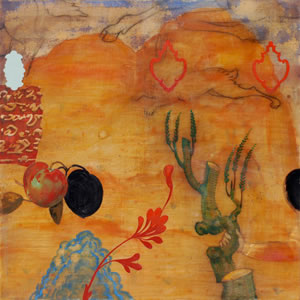
| return to top |
| return to top |
| return to top |
| return to top |
| return to top |
| return to top |
Back to the Garden
June 6 - July 20, 2008
Cara Enteles, Melanie Fischer, Callie Danae Hirsch, Susan Homer, |
|||||||||||||||||||||||
|
We are always inventing an imaginary Eden of one sort or another for ourselves, to relieve us of the complex burdens of our humanity.
With summer around the corner, Metaphor is pleased to present, Back to the Garden, an exhibition featuring a wonderful group of artists who address this primal urge in their work and who, for a couple of months, will turn the gallery into our own corner of Eden. Artmaking like gardening is an inherently optimistic activity and the works of these artists lead us into summer with a rich, diverse, and hopeful consideration of the beauty and release to be found in the garden. The onset of the milder days of spring and summer turns many a mind to the quest for their own little bit of Eden. Whether in a few pots on a fire escape or window sill, or an elaborately landscaped backyard, the urge to join in the creative processes of nature surges through us humans like sap through a tree. Gardening gives us a chance to remake our world and at the same time offers us respite from it. Gardening immerses one in the natural world. To make a garden there is planning to do, site preparation, choice of plants, research, then on to the actual digging and planting. This is the fun stuff and can be accomplished quickly enough. The rest is the long work of nurture as the gardener comes to know the garden with a heightened intimacy as it unfolds season after season, as plants die and need to be replaced, as vines run rampant and need restraint, as roses require their fussy array of prunings, and as the gardener develops a better understanding of what can and will not live and thrive in his or her particular patch of earth. There is also the question of sensibility as the gardener begins to define and refine the aesthetic of the garden, its' mass and color, its' associations. In all of this gardening resembles and provides an apt metaphor for artmaking. Nature is the original source material of art. Its' beauty, chaos, and stark power have for centuries spurred artists to copy from it, interpret it, and channel it. In some ways individual artworks can be considered as gardens of the mind, small, discreet, carefully tended bits of the greater whole which is all encompassing nature itself. Artists have confronted the dilemma of being at one with and simultaneously apart from nature since the beginnings of human sensibility. Now, confronted with the spectre of global environmental collapse artists who choose nature as a subject continue this engagement more mindful than ever of this essential and troublesome duality. Eden may be lost to us, but it is now contingent upon all of us to nurture our bit of earth as best we can that we may all continue to live and thrive upon it. We are the gardeners of our planet, and like food or beauty, we need it to survive. |
||||||||||||||||||||||
HOME . ABOUT US . ARTISTS . CURRENT EXHIBITION . UPCOMING EXHIBITION
ARCHIVE . DIRECTIONS-MAP . CONTACT . SUBMISSIONS










